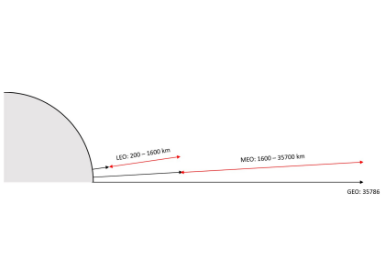Communications
A Journey with Stars
"Twinkle, twinkle, little star. How I wonder what you are?"
The mysterious allure of the night sky is always kindling the imagination of many – Luke Skywalker, Cybertron, E.T., Moonraker – just to name a few examples. Despite these imaginations, those shining stars high above the sky have been with us for years and years, among which are the youngest members – man-made satellites.
Knocking on Heaven’s Door
Inspired by Sir Arther C. Clarke's article "Extra-Terrestrial Relays", we extended our touch beyond the sky and opened the door of the Space Era. Sputnik-1, Explorer-1, GPS, Beidou, Voyager, Hubble, thousands of artificial satellites have been sent to space, either linking people with each other around the globe, or bringing convenience and safety to the society, and even exploring the ultimate boundary of our world. Transoceanic TV, weather forecast, real-time navigation, consciously or unconsciously, our lives are profoundly affected by these objects floating in the cosmos.
One major mission of satellites is to realize global communication. It’s easy for us to understand that the radio signal sent from the tower on the ground will be blocked by terrain as it travels. Like the saying in an ancient Chinese poem, “You can enjoy a grander sight, by climbing to a greater height”, the higher the tower, the further the signal goes. A satellite can act as an ultra-high communication tower to deliver signals to earth, avoiding blockages from the terrain, and in theory "three satellite stations will ensure complete coverage of the globe."1

Figure 1. Illustration of three satellites ensuring complete coverage of the globe
Over the past decades, various types of satellite communication systems were developed and deployed to provide global/regional communication services, of which some are broadband to fixed earth stations and some are direct communication to mobile handsets. One famous representative is Iridium, a mobile satellite system capable of on-board processing and inter-satellite communication, supporting global direct communication with handheld user terminals. However, limited by technologies, business modes, etc. of the time, these service providers did not gain economies of scale from the market as the terrestrial mobile networks expanded quickly in 1990s to 2010s and met most demands of mobile communication customers.
New Era, New Business, and New Standards
Thanks to the advances of satellite technologies, e.g., battery, solar power panel, Hall thruster, etc., new types of satellite platforms are emerging which are more efficient, powerful, and stable. Meanwhile, the demand of seamless global mobile communication, especially in remote or unserved areas, is increasing as we stepped in the 21th century. The satellite industry started to look at new business opportunities by integrating the terrestrial mobile cellular communication technology into satellite: that is the 3GPP New Radio (NR) technology or the so-called 5G.

Figure 2. Development of mobile cellular and satellite communication
Many people may have heard about 5G, described by some as the cornerstone that is helping to change the way we live and work. 3GPP is the de facto global standardization organization that has been developing technical specifications for 3G, 4G, and 5G wireless technology. Since 2017, mobile and satellite industries started the work in 3GPP Technical Specification Group (TSG) Radio Access Network (RAN) on NR to support non-terrestrial networks (NTN) of which the satellite is one major target. Studies have been carried out to explore possible scenarios of NTN, examine the feasibility to adopt NR in NTN and investigate potential impacts to existing NR specifications for such adoption.
With these preparations summarized in 3GPP Technical Report (TR) 38.811 and 38.821, 3GPP TSG RAN decided to specify the enhancements identified for NR NTN in Release 17 in Dec. 2019, meaning the start of the standardization of NR NTN. The work in RAN Working Groups 1/2/3 mainly focused on updating existing 5G NR specifications and in RAN Working Group 4 (abbreviated as RAN4), new specifications were to be developed to define detailed requirements on radio frequency, radio resource management, demodulation performance, and conformance testing. And I, as a Samsung delegate, have been deeply involved in the work in RAN4 and witnessed the birth of these new specifications.
We’re Coming for Peace.
Talking about the work in RAN4, one important item is to define Radio Frequency (RF) requirements of NR NTN to ensure its components will not interfere traditional terrestrial mobile networks (TN) using the same NR technology, which is called co-existence in RAN4.
If you were following the BLOG of Samsung Research, you might be aware of the fact that terrestrial mobile industry and satellite industry have been arguing with each other for years to secure frequency resources for their services (Looking back at 5G to build future 6G in ITU-R2). Then imagining the similar scene in RAN4 would be an easy work for you, let alone that the target NTN satellite operating bands are just next to or overlaps with existing TN bands.

Figure 3. NTN satellite operating bands (orange bars) and TN bands
In each meeting, there were heated debates between different companies over a diverse range of issues. As the moderator of NR NTN co-existence study, our job is to organize relative discussions, find out key issues, keep the conversation on track, figure out possible ways out, provide compromised solutions and sometimes remind myself to keep calm with my dear partners – a bunch of big boys and girls with a little temper but quite collaborative.
Despite the old scores, the mobile industry and satellite industry walked towards each other and worked together with great understanding and tremendous joint efforts. From Jan. 2021 to March 2022, we carried out the work on NR NTN co-existence study in Release 17, which is the foundation to define RF requirements of NR NTN Satellite Access Node (SAN) and User Equipment (UE). And in June 2022, the following documents have been officially approved in the RAN Plenary meeting:
- Technical Report (TR) 38.863 to summarize NR NTN co-existence study results;
- Technical Specification (TS) 38.101-5 to define NR NTN UE RF and performance requirements;
- Technical Specification (TS) 38.108 to define NR NTN SAN RF and performance requirements.
It’s a big relief to us as the editor of TR 38.863 and TS 38.101-5 seeing these documents approved in time. And now, let’s take a glance at the NR NTN satellite system defined in Release-17 from the RAN4’s perspective.
The overall NR NTN satellite system architecture is shown in Figure 4. The SAN consists of the following components:
- the NTN-Payload in transparent mode;
- the feeder link which is used to connect the satellite with the NTN Gateway;
- the NTN Gateway (NTN-GW);
- the non-NTN infrastructure gNB functions which implement the 5G NR functionalities.
The whole system is defined in a transparent architecture and RAN4 set out requirements for the service link using NR-Uu interface between UE and SAN.

Figure 4. NR NTN Satellite System Architecture in Release-17
For NR NTN SAN, two SAN classes, Low Earth Orbiting (LEO) and Geostationary Earth Orbiting (GEO), have been defined as presented in Table 1 and relative requirements in TS 38.108 apply.

Table 1. SAN classes
Two NR NTN satellite operating bands have been defined as presented in Table 2, namely the traditional S-band and L-band for satellites, respectively.

Table 2. NTN satellite operating bands defined in Release-17
From UE side, a handheld type UE equipped with an omni-directional antenna working at 23 dBm power level (Power Class 3) is considered. Most importantly, the minimum RF and performance requirements for NR NTN UE defined in TS 38.101-5 are very similar to or aligned with those of the traditional NR TN UE defined in TS 38.101-1, i.e., 30 dB of Adjacent Channel Leakage Ratio (ACLR) and 33 dB of Adjacent Channel Selectivity (ACS). The NTN capable NR UE minimum RF and performance requirements are therefore aligned with the TN capable NR UE minimum RF and performance requirements. This makes it possible that a UE implementing TS 38.101-5 functionalities for connectivity with NTN can also implement TS 38.101-1 functionalities for connectivity with TN without fundamental changes to its hardware. It means using your smart phone to connect with satellites will be possible in the near future!
To Be Continued
Extending the art of the possible is what we do at Samsung. The work on NR NTN in 3GPP is not done yet. Enhancements on NR NTN will start for Release 18 to further optimize satellite access performance, address new bands with their specific regulatory requirements, and support new capabilities and services as the evolution of 5G continues. There are still significant technical and business challenges to be overcome if satellites are to be successfully deployed at scale. Standards and spectrum are important elements to be sorted out and it’s a great pleasure and fortune for me to be part of this journey. And I would also like to thank all my partners from either mobile or satellite industry in this journey since you’re the real stars to shine up our future.
References
1. "Extra-Terrestrial Relays", 1945 October issue of Wireless World, pages 305-308.
2. Samsung Research: Looking back at 5G to build future 6G in ITU-R.






